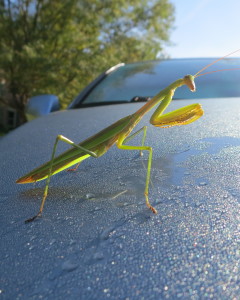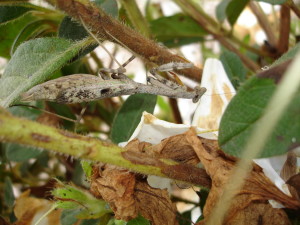Carolina Praying Mantis (often written “mantid”, referring to family Mantidae) (Stagmomantis carolina) is the only species of praying mantis native to the U.S. However, about 20 species are found in the U.S. Most ubiquitous here is the European mantis (M. religiosa). Chinese Praying Mantid (Tenodera aridifolia) is the largest species by size in the U.S., measuring almost 4 inches in length. They’re easily purchased in kits for school age children who raise them as a pet or study mantids as part of a nature project.
Praying mantids are typically green or brown and can disguise themselves as a dried slender leaf or twig. Praying mantids are named for their prominent front legs, which are bent and held together at an angle that suggests the position of prayer. Mantids are formidable predators. They have triangular heads poised on a long “neck,” or elongated thorax. They can turn their heads 180 degrees to scan their surroundings with two large compound eyes and three other simple eyes located between them. No other insect can do that.
Praying mantids lie in wait to capture their quarry, be it moths, crickets, grasshoppers, flies, and other insects. An adult female sometimes eats her mate after mating. Mantids snare their prey with their front legs with rapid reflexes. Their legs are further equipped with spikes for capturing and pinning their prey.
Females regularly lay hundreds of eggs in a protective egg case (ootheca), and nymphs hatch looking much like tiny versions of their parents. People may be shocked to find several hundred hatchlings coming from egg cases attached to firewood that was brought indoors.
Larger species of mantids can catch and eat lizards, frogs, and even tiny birds like hummingbirds. Mantids don’t discriminate between good bugs and bad bugs such as beneficial bees, lacewings and moths. To turn the tables, bats feed on praying mantids.



 Posted in
Posted in 
